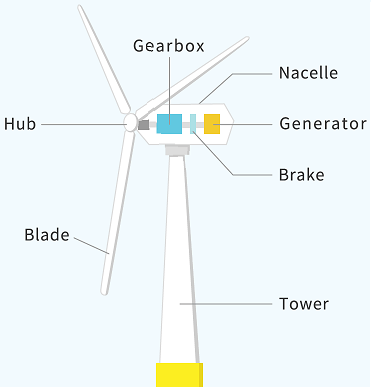Wind energy is an indirect form of solar energy since wind is produced chiefly by the uneven heating of the earth’s crust by the sun. The kinetic energy of the wind can be utilized to produce with the help of wind turbine.
Wind Power Plant Working Principle
As the free wind stream interacts with turbine rotor, it transfers a part of the kinetic energy to the rotor due to which its speed decreases. This difference in kinetic energy is converted into mechanical power.
The total wind power is equal to the incoming kinetic energy of the wind stream. It can be expressed as:
Total wind power, Pt = (ρACi3)/2
Where, ρ = density of air (in kg/m3); A = rotor swept area = πr2 (r = radius of blades in meters); Ci = incoming wind velocity (in m/s).
The density of air (ρ) is somewhat complicated since it depends on the definition of “ideal” air, the temperature, the altitude, and the water vapor content. It is approximately 1.2 kg/m3 at sea level and room temperature, a value which is sufficiently accurate for our purposes.
From the above equation, it is clear that total power of a wind stream is proportional to the cube of incoming wind velocity, the density of air and the rotor swept area. Hence, any small increase in wind speed can produce a significant rise in developed wind power.
Horizontal Axis Wind Turbine Generator
Horizontal axis wind turbine generators are being used all over the world successfully. The main components of a propeller type wind generator are shown in Figure.

- Usually, it has two of three blades made of high-density glass fiber reinforced plastic. The diameter of rotor ranges from 2 to 25 m. Modern rotors may be up to 100 m in diameter. Rotor blades are assembled on a hub.
- The hub, brakes, gearbox, generator with electrical controls is accommodated in a box called nacelle.
- Electromagnetic brakes are provided for automatic application of brakes if wind speed exceeds the designed speed.
- The whole system is mounted on a tower top. It is designed to bear up the wind loads during storms.
- A yaw control mechanism is also provided to adjust the nacelle around a vertical axis to keep it wind facing. A servomechanism operated by a wind direction sensor controls the nacelle so that the turbine blades are always oriented in the direction perpendicular to wind to have the maximum wind stream area.
- The pitch of the blade (0o to 30o) is controlled automatically so as to provide the feathering action. Thereby the power and speed of wind turbine shaft are adjusted to match with generator speed and its electrical output. The pitch control mechanism adjusts the pitch to obtain the optimum performance.
- The wind energy is converted into mechanical energy by an aero turbine. This mechanical power is transferred through gears to the generator to increase its speed. Since rotor speeds are low, a gear system is necessary to match the synchronous speed of the generator.
- Due to fluctuations in wind speed, it not possible to obtain a power supply of a fixed frequency from windmills. To overcome this problem, the output of 3 phase generator is rectified and converted into AC with the help of a PWM inverter operating at 50 or 60 Hz.
Site Selection for Wind Power Plant
As we know that the total wind power from free wind stream increases as the cube of the wind speed, therefore, the location of wind power plant should be decided very carefully. Wind energy can be used where wind speeds are reasonably high in the range of 8 to 40 km/hr.
Such wind speeds are available along the sea coast at high altitudes and in hilly terrain. Some of the important criteria for selection of a site for wind energy conversion system (WECS) are as under:
- The WECS should be located where high average wind velocities available are in the range of 6 m/s to 30 m/s throughout the year.
- The WECS must be located far away from cities and forests since buildings and forests offer resistance to wind.
- Wind velocities must be measured at several heights as the velocity of wind increases with height.
- Tower design must be adequate to withstand maximum wind speeds observed in the last few years in the area of installation.
Wind Power Plant Advantages and Disadvantages
Advantages
- It is a free and un-exhaustible source of energy.
- It is a clean and non-polluting source of energy.
- It has a low maintenance cost.
- It has a low cost of power generation (about Rs. 2.25/kWH).
Disadvantages
- At present capital cost of wind power plants is high. It is about Rs. 3.5 crores/MW.
- Wind energy is very fluctuating in nature. It is very difficult to design a wind energy system due to these fluctuations. This problem also requires the provision of a suitable storage device to ensure continuous power supply.
- Large variations in wind speed during storms may cause damage to windmills.
- The efficiency of the system is in the range of 35 to 44%.
- Windmill causes sound pollution. A large unit can be heard few kilometers away.
Thanks for reading about wind power plant working principle.
Related Posts
- Wind Power Plant Working Principle
- Wind Power vs Solar Power | Pros and Cons
- Wind Energy Systems
- Wind Energy Advantages and Disadvantages
- Generation and Types of Wind
- Calculation of Wind Power
- Types of Wind Energy Systems
- What to Look for When Buying a Wind Machine
- Proper Siting of a Wind Machine
- Assessing Your Wind Resource
- Inverters for Wind Energy System